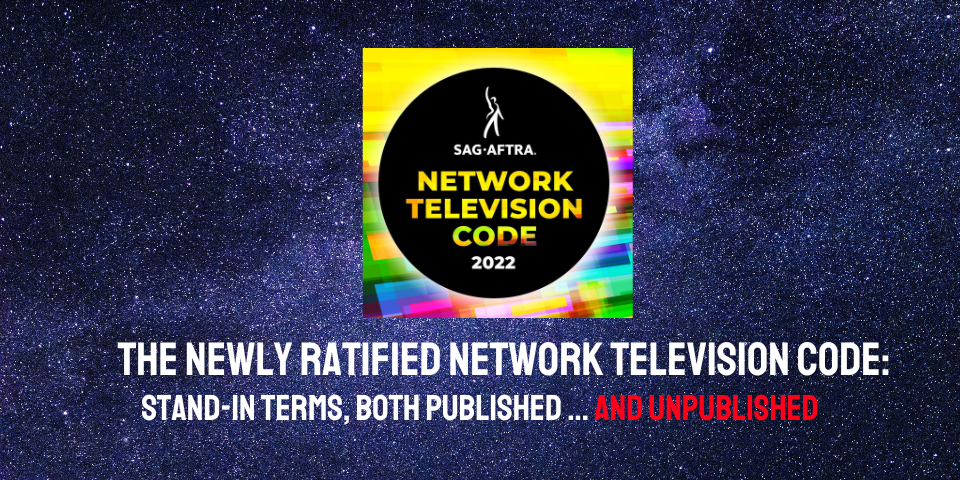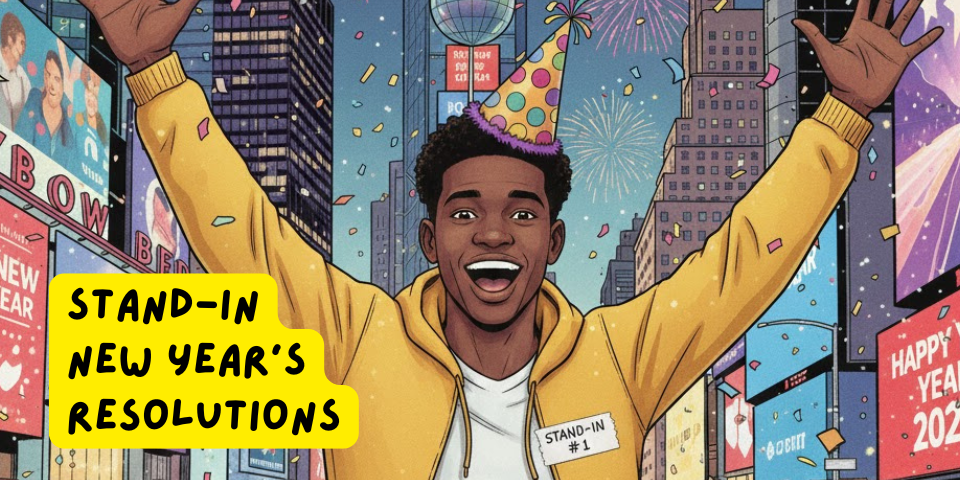On July 8, 2022, SAG-AFTRA announced that a majority of SAG-AFTRA members voted to ratify the proposed successor agreement to the Network Television Code (“Netcode”)
Of interest to stand-ins, the Netcode is the SAG-AFTRA collective bargaining agreement that covers stand-in work on promos, variety shows, game shows, talk shows, soap operas, and other productions. The 2014 master agreement is linked here.
The Netcode is an “old AFTRA contract,” in that AFTRA administered it until SAG and AFTRA merged in 2012. It has considerably different terms than the Television Agreement and the Theatrical Agreement, which were administered by SAG before the 2012 merger. More stand-ins seem to work under the Television and Theatrical Agreements than under the Netcode. Anecdotally, many stand-ins don’t seem to know much about the Netcode or its peculiarities, and often they are surprised to find things aren’t the same for stand-ins under the Netcode as they are for stand-ins under the Theatrical or Television Agreements.
The predecessor Netcode was to expire on June 30, 2021 (over a year ago). SAG-AFTRA agreed to extend the Netcode multiple times before reaching a new agreement last May. Referred to as the “2021” Netcode rather than the 2022 given its retroactivty to July 1, 2021, the new Netcode remains in effect through June 30, 2024.
This post goes into the 2021 Netcode as it applies to stand-ins, covering both published and unpublished aspects of the SAG-AFTRA collective bargaining agreement.
Stand-Ins and the New Netcode
In June and early July 2022, SAG-AFTRA members voted via referendum whether to ratify the proposed Netcode successor. SAG-AFTRA published a summary document about the proposed agreement it negotiated with producers.
Ben’s Note
The summary document was not the contract language, and it left details out. Providing to SAG-AFTRA members only a summary of the agreement calls into question whether SAG-AFTRA members would have ratified the proposed Netcode had it known all of the terms SAG-AFTRA negotiated around it, rather than simply the terms SAG-AFTRA summarized.
On its website, SAG-AFTRA later released a copy of the Memorandum of Agreement (“MOA”) for the new Netcode, which “reflects the complete understanding reached between the parties regarding agreed-upon modifications.”
What Netcode Modifications Apply to Stand-Ins?
As covered earlier on Stand-In Central, there are a number of changes to the rates and minimum hours for stand-ins under the new Netcode, plus some other modifications.
Daily stand-ins (those working with 8-hour minimums on dramatic television programs under the Netcode) saw a 3% increase in their daily rate.
Hourly stand-ins generally saw $1 increases in their hourly wages for some years of the contract, as well as increases in their minimum hours. However, no hourly stand-ins gained a daily rate (i.e., an 8-hour minimum), so some stand-ins may still take home less than $100 when they work a day as a union stand-in, depending on the production.
Also, stand-ins will receive $14 for work in artificial rain, smoke, and snow, but questions remain about when exceptions to that bump apply.
Retroactivity for aspects of the new Netcode apply, meaning, for example, for work performed from July 1, 2021, until the date of ratification, stand-ins may receive retroactive payments due for that work.
These modifications appeared in the summary SAG-AFTRA released before ratification, and they also appeared in similar language within the MOA.
The Unpublished Award Show Sideletter
However, in the summary, SAG-AFTRA did not mention all terms and conditions it had negotiated around stand-ins. Namely, SAG-AFTRA did not mention a sideletter referenced in the MOA that contained additional language relevant to stand-ins.
Near the end of the MOA, the new Netcode references an “Unpublished Sideletter.” The sideletter pertains to “Award Show Waivers” and explains these waivers are an “attached” “Discussion Item.”
However, to make matters more opaque for SAG-AFTRA members, the sideletter is not actually attached to the new Netcode — at least not the online version SAG-AFTRA published. Stand-In Central is hosting the Unpublished Sideletter here.
Contents of the Unpublished Sideletter
Titled, “Unpublished Sideletter: Waivers for Presenters Award Show Programs. Standard waiver to be utilized below:,” it regards “Presenters and Acceptors on Awards Programs,” while also touching on both waivers of compensation should a performer’s covered work appear in the awards show and stand-in requirements.
The sideletter’s language on stand-ins is better understood after reading its language on presenters and acceptors. The sideletter begins:
During negotiations for the 2014-2018 Network Code, the parties agreed that Producers would be offered waivers for presenters and acceptors on awards programs to the same extent and on the same terms that the Union has granted such waivers in the past to other producers of awards programs such as for “The Golden Globe Awards,” “The Academy Awards,” and “The Grammy Awards.” Those terms and conditions include but are not limited to the following:
a) Presenters and acceptors may agree to a waiver of their compensation provided that they confine their appearances to the usual, brief exchanges and/or actions of presenters and acceptors and do not perform in such categories as those of singer, dancer, actor or specialty act.
It is somewhat odd that presenters and acceptors on Netcode award programs would agree to a waiver of due, Netcode-required, minimum, union-negotiated compensation that would presumably contribute toward their health and pension eligibility. It is unclear if, with a waiver of such compensation, whether those presenters and acceptors lose any status as “employees” when appearing on these award shows. These questions are outside the scope of Stand-In Central but possibly something to consider, especially given workplace violence that appeared to occur by and against SAG-AFTRA members during the live broadcast of the 2022 Oscars award program.
More to the scope of Stand-In Central, the sideletter continues with language affecting stand-ins. It reads:
b) In consideration of the waiver, Producers agree to hire one-half as many stand-ins as there are presenters, all of whom will be “qualified professional performers” not affiliated with the production.
A “qualified professional performer” is a person who has had prior employment in the entertainment industry at least once during the period three years prior to the date of the proposed employment.
Presently, it is unknown the requirements a Netcode producer of an award shows typically has with respect to stand-ins. Does the Netcode or past practice require a Netcode producer to hire one stand-in per presenter? Can the producer double up stand-ins to stand in for multiple presenters? Answers to these questions would help determine if, in consideration of the sideletter’s compensation waiver, requiring a producer to hire half as many stand-ins as presenters is a heavier employer burden or union lightening of employer obligations.
Also not clear is why SAG-AFTRA requires those stand-ins to be “qualified professional performers.” What the language appears to imply is a past practice of award show producers having people who were not hired from the SAG-AFTRA unit standing in during awards shows, possibly crew or other nonprofessional performers. That is purely speculation, though.
Why Did SAG-AFTRA Agree to Make the Sideletter “Unpublished”?
When Stand-In Central’s editor asked a SAG-AFTRA associate general counsel in a recent email why the sideletter was unpublished, the union lawyer explained, “This sideletter is not published since it is not in the Union’s interest to publicize available waiver terms more broadly than necessary (ie: the bargaining parties already have this letter).”
Stand-In Central’s editor replied to the union lawyer in part, “For what it’s worth, it is in the interest of SAG-AFTRA unit members to know the terms and conditions of employment under which they will work or do work when working as employees under a collective bargaining agreement […] I hope the Union will consider my and other unit members’ interests […] before agreeing not to publish waivers of CBA language.”
Waivers of negotiated language can be dangerous for union member collective bargaining rights. That SAG-AFTRA apparently takes a position that publicizing waiver terms not beyond the bargaining parties is “not in the Union’s interest” may be a cause for concern for stand-ins. Imagine showing up to a stand-in job under the Netcode, which has with it certain guarantees of payment and work conditions, and finding SAG-AFTRA did not tell you it had waived some of those guarantees. Would you have worked the job if you knew the union waived those negotiated work conditions?
When Retroactive Payments Will Arrive, According to SAG-AFTRA
Oddly, the MOA does not appear to disclose exactly when producers signatory to the Netcode will have to pay retroactive payments to stand-ins who worked from July 1, 2021, through the date of ratification.
However, in a brief video presentation SAG-AFTRA published on YouTube titled “What’s New in the Network Television Code: Wages,” SAG-AFTRA addressed questions about the new Netcode.
At 11:46, the host asks, “How and when will we receive retroactive wage increases for work done after July 1st of last year (2021)?” Ray Rodriguez, a SAG-AFTRA negotiator, asserts, “Those payments should come in within sixty days of ratification … Sixty days from this past Friday.” Per the date of the video, sixty days from July 8, 2022 is about Tuesday, September 6, 2022.
So, given Rodriguez’s assertion, stand-ins who are due retroactive payments should receive them by around September 6, 2022.
Rodriguez advises contacting SAG-AFTRA if those retroactive payments aren’t received. Listening closely, those retroactive payments only apply to work at scale. A stand-in working above the minimums in the Netcode would not be due a retroactive payment.
What about 8-Hour Minimums for All Netcode Stand-Ins?
Toward the end of the video, at 15:02, Rodriguez speaks to the gains stand-ins made under the new Netcode. Surely, stand-ins received wage increases, but what about the issue of stand-ins having as low as two-hour minimums, meaning they could have left a union job with less than $60 to show for their union stand-in work?
Rodriguez asserts SAG-AFTRA attempted to negotiate 8-hour minimums for hourly Netcode stand-ins. However, yet again, SAG-AFTRA agreed to accept less than 8-hour minimums for hourly stand-ins. Rodriguez asserts in the video:
Stand-ins don’t necessarily work a full day, and that has been a point of frustration for our stand-in members. They really want to have an eight-hour day. We [SAG-AFTRA] sought to achieve that. That was the proposal. But as we went through negotiations, we agreed to certain minimum-call increases. If you look in the summary, there is a provision in the summary that describes how those minimum calls improved. That’s almost more significant than the wage increase itself, because the guaranteed minimum call that you’re now gonna get, it has gone up by one or two hours, depending on which category of programming.
Based on Rodriguez’s reply, SAG-AFTRA agreed to minimum-call increases rather than the proposal that hourly stand-ins should have an eight-hour day. Rodriguez went into no other details why.
However, Rodriguez appears to attempt to “look at the bright side” (or maybe “polish a turd”) by implying an increase in hourly minimums for hourly stand-ins constitutes an “almost more significant” increase than the $1/hour wage increase seen in some years of the new Netcode.
It appears he means, for example, that stand-ins with two-hour minimums, who in the prior Netcode could take home just $58 for the day, will today take home at least $93 (3 hours at $31/hour). Doing the math, that is around an 80% increase in minimum take-home wages, compared to the 3% increase daily stand-ins’ take-home minimums. But even doing the math, the fact is these hourly stand-ins could take home less than $100 for effectively a day of professional work in a unionized environment, and most of these stand-in jobs are in expensive big cities like New York and Los Angeles.
In all, it’s a wonder SAG-AFTRA did not fight harder for hourly stand-ins to achieve 8-hour minimums. But we do know that SAG-AFTRA purportedly had 8-hour minimums for Netcode stand-ins as a bargaining proposal and sought them during recent negotiations. Given SAG-AFTRA makes its negotiations confidential, it’s hearsay for now whether any of Rodriguez’s assertions about what SAG-AFTRA sought for hourly stand-ins are true.
Conclusion
Keep a look out over the next month for retroactive payments for your stand-in work over the past year. If you are due retroactive payment but don’t receive it, start inquiring with SAG-AFTRA as soon as possible after September 6, 2022.
Thoughts about the new Netcode? Did the unpublished sideletter surprise you? Post your reactions in the comments section below!







Leave A Comment